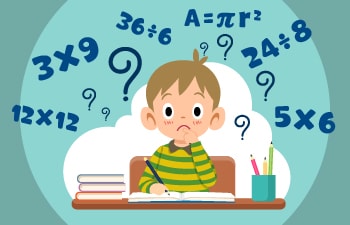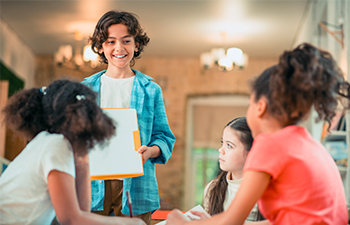As you start to think about setting math goals for students, remember that SMART goals are specific, measurable, achievable/attainable, relevant/realistic, and time bound. In math instruction, there are five interrelated components that should be the foundation of goals, strategies, instruction, and assessments to work towards mathematical proficiency:
- conceptual understanding
- procedural fluency
- strategic competence
- adaptive reasoning
- productive disposition
The fifth component, productive disposition (appreciation of math and feeling of one’s own competence with the subject), may not be featured directly in your state’s standards, as a homeschool family, you may be uniquely positioned to nourish the development of this component in your child.
What Should Homeschool Math Goals Include?
In addition, when writing math goals for students, you will want to consider the five Content Strands:
- Number and Operations
- Algebra
- Geometry
- Measurement
- Data Analysis & Probability
We will take each of these in turn to examine potential math learning goals examples.
Number and Operations
If you look at the expectations for Number and Operations, you will see that the content strand is divided into three sections: Number, Operation, and Computation.
Example Number and Operations Goals
A Pre-K-2 expectation under Number states, “count with understanding and recognize ‘how many’ in sets of objects.” To make a good math goal for your student, you would want to write something like this:
- By the end of the year, and given objects, my child will be able to count (by moving objects) up to ____ with ___% accuracy.
Be careful if the expectations use a verb like “understand” as including such a term in your goal would not be measurable.
For example, a Grades 6-8 expectation under the Operation tab states, “understand the meaning and effects of arithmetic operations with fractions, decimals, and integers.” You may want to modify this to a goal that is more easily assessed:
- By the end of the year, and given numeric (or word) problems, my child will be able to add (subtract, multiply, divide) fractions (or decimals, or integers) up to one whole (100….) with ___ % accuracy.
- By the end of the year, my child will be able to identify the information needed, the correct operation, set up the problem and solve 2-step math word problems.
Each of the variations in parentheses could be a separate goal.
Algebra
When you examine the Algebra expectations, you will see that there are four main objectives that students in preK through grade 12 should be working toward:
- Understanding patterns, relations, and functions
- Representing and analyzing mathematical situations and structures using algebraic symbols
- Using mathematical models to represent and understand quantitative relationships
- Analyzing change in various contexts
As with the Number and Operations goals, you will want to write Algebra goals that are measurable from these expectations. You can look at your state’s grade-level standards in order to be specific within each of the expectations.
Example Algebra Goal
For example, a Grades 9-12 algebra expectation for representing and analyzing mathematical situations and structures using algebraic symbols is to “understand the meaning of equivalent forms of expressions, equations, inequalities, and relations.” You might choose a goal something like this:
- By the end of the year, and given sets of equations and/or inequalities, my child will be able to graph the solutions with ___% accuracy.
- By the end of the year, my child will be able to solve systems of two linear equations with two variables for real-world problems.
Geometry
Geometry goals can focus on four areas:
- Analyze characteristics and properties of two- and three-dimensional geometric shapes and develop mathematical arguments about geometric relationships
- Specify locations and describe spatial relationships using coordinate geometry and other representational systems
- Apply transformations and use symmetry to analyze mathematical situations
- Use visualization, spatial reasoning, and geometric modeling to solve problems
Example Geometry Goal
For example, a Grades 6-8 geometry expectation for the first area is to “understand relationships among the angles, side lengths, perimeters, areas, and volumes of similar objects.” A related goal may be something like this:
- By the end of the year, and given a diagram of an object, my child will be able to accurately determine the properties (or perimeter, area, or volume) of the object with ___% accuracy.
Again, you may create separate goals for each of the criteria related to the object. Combining more than one criterion within a goal may make it less measurable. For example, if you have an “and” within your goal, your child may be able to accomplish one task but not the other. The goal would therefore be unmet, not giving correct credit to the success that your child did have.
Measurement
When writing Measurement goals, you will want your child to understand the measurable attributes of objects as well as the units, systems, and processes of measurement. Application will require your child to be able to use appropriate tools, techniques, and formulas in order to measure objects.
Example Measurement Goal
A PreK-2 child who is working toward the expectation of “understand[ing] how to measure using nonstandard and standard units” might have these two goals:
- By the end of the year, and given furniture items, my child will be able to use his/her body (or other nonstandard unit) to measure the relative length of individual pieces with ___% accuracy.
- By the end of the year, and given furniture items, my child will be able to use a standard one-foot ruler to measure the length, in inches, of individual pieces with ___% accuracy.
As you start to think about your students learning objectives examples for math , brainstorm ways to help your child accomplish them!
Data Analysis & Probability
The final section, data analysis and probability, also focuses on four areas:
- Formulate questions that can be addressed with collecting data, organizing, and displaying relevant data to answer them
- Select and use appropriate statistical methods to analyze data
- Develop and evaluate inferences and predictions that are based on data
- Understand and apply basic concepts of probability
Example Probability Goal
A goal for a child in Grades 3-5 might be based on the expectation stating, “represent data using tables and graphs such as line plots, bar graphs, and line graphs”:
- By the end of the year, and given data from two sports teams, my child will be able to accurately represent the data by drawing a bar graph showing all data points and all required titles and headings.
Remember, too, that you can set quarterly benchmarks for each goal or determine which goals can be met during each quarter. Focus on that fifth component and help your child learn to love math!
Learn tricks and strategies to help support your student in math!











Do you have any goals for all subjects in math?
Hi! Thanks for stopping by. The blog post outlines goals for most age/grade bands across multiple different math concepts. What additional math goals were you looking for?